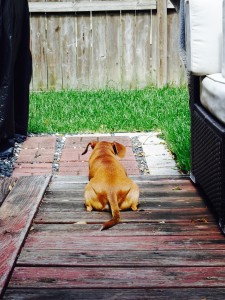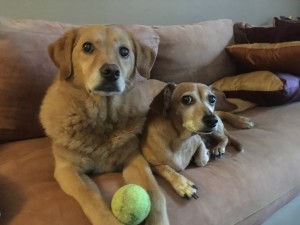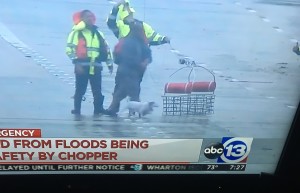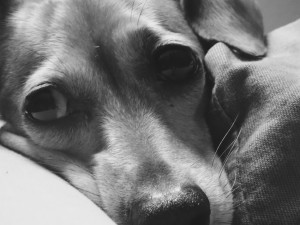Michael Baugh CDBC CPDT-KSA
I’ve been thinking a lot about why people don’t train their dogs. It’s one of those Holy Grail questions for professional dog trainers and behavior consultants. Why won’t my clients do what I tell them to do? We laid out a great training plan. But they just won’t do what I said.
 The excuses are as predictable as they are vexing. I didn’t have time. I’ve been so busy. I’m not coordinated enough. I don’t have the right tone of voice. I’m not good enough. Then there are the ones that blame the dog. He’s stubborn. He’s dominant. He won’t do it. He’s too old – too young – too dumb – too distracted. We trainers hear these things – and believe me, we’ve heard them all – and it’s tempting to respond to each one individually in voluminous detail. Of course, in our heads we are much more succinct. No. That’s not true. Stop saying that. Just stop it. Stop.
The excuses are as predictable as they are vexing. I didn’t have time. I’ve been so busy. I’m not coordinated enough. I don’t have the right tone of voice. I’m not good enough. Then there are the ones that blame the dog. He’s stubborn. He’s dominant. He won’t do it. He’s too old – too young – too dumb – too distracted. We trainers hear these things – and believe me, we’ve heard them all – and it’s tempting to respond to each one individually in voluminous detail. Of course, in our heads we are much more succinct. No. That’s not true. Stop saying that. Just stop it. Stop.
It’s funny. As I’ve been thinking about this, it’s become very clear that we trainers complain about clients in very much the same tone that clients complain about their dogs. We label our clients. Then we tell stories about them using those labels. You see where I’m going here? It’s exactly what we do with our dogs. Stubborn. Dominant. Distracted. All labels. Each equally useless.
So what’s really going on? Here’s what I think. Those of us who really love training do it because it’s freaking fun – thrilling – a hoot. The process is equal parts suspense (will it work) and joy (of course it will – always does). In other words, our behavior (the act of teaching our dogs) is reinforced. Trainers, professional or hobby enthusiasts, thrive on reinforcement from – wait for it – our dogs. Success. Seeing it work. It’s why we train. It’s what keeps us going.
Side note: dogs learn when they begin to see their actions affect the environment around them. We humans are the best candidates for showing them how that works. Flip side. Trainers learn when we begin to see our actions affecting the environment too – and our dogs fill that bill for us. Who’s training whom? Can’t tell? Good, you’re doing it right.
So what gets in the way of training? New trainers (clients) give up when they haven’t had that first sweet taste of success. It’s like the first episode of a new TV series. If it’s lackluster, you might not keep watching. But if there’s a hook, or even the tiniest bit of a wow moment, you’ll cancel dinner plans and binge watch the whole season. Trainers, even new trainers, depend on reinforcement. Absent the reinforcement, the behavior dies. Training fails.
Now, I’m not blaming your dog for not reinforcing you properly. That’s not how this works. He’s potentially as bored and checked out as you are. What we need here is just a little spark, something to get the conversation started between you two. We need to set the table for that first taste of back-and-forth reinforcement. Some delicious quid pro quo.
Do this: start simple. Just a taste. I intentionally teach hand targeting to all my clients first. (Now you know my secret). It’s the appetizer – the ice breaker – the first reinforcer for the dog and the human. You do this and I do that. Oh my goodness, I did that and you did this. And we’re up and running. Easy peasy.
But hold on, not too fast. Start simple, yes, and build gradually. Set yourself up to succeed every step of the way. Set your dog up to succeed, too. When we rush the process things can falter and we end up starving ourselves of reinforcement. Our dog stops responding and we lose that thrilling feeling of success. We pushed too far too fast. That’s when all those labels and damaging stories we tell about our dogs start creeping back.
Stop it. Just stop.
Dail it back and shake it off. Get yourself tall cool glass of winning. Work on something easy with your dog – maybe a trick that makes you laugh. Taste the success. Show your friends. Make them laugh too. Reinforce the dog’s behavior generously. Move around a bit. Go for a hand target or a sit. Reinforce again. Feel the reinforcement. Then, and only then, are you ready to circle back to the main course of incrementally more challenging tasks. Take it easy on yourself and your dog. Little by little. Sure and steady.
Here’s the bottom line. You can train your dog. And here’s the bottom line to the bottom line. You can learn to love training, too. Okay and here’s something even better. You’re in control. Yes, I’ve had some philosophical thoughts about control in the past, but what I mean is you can set all this up to work for you. For your dog. You can do this.
And when you feel like you can’t – email me – use the subject line “I’m stuck” if you want. I’ll help you clear your head so you can get back up to the buffet for another plate full of reinforcement – rich and delectable success.
Michael Baugh teaches dog training in Houston TX.

 The storms this year, and Harvey in particular, got me thinking long term about what we all need to teach our dogs so that we are well prepared for next year’s hurricane season and the ones to follow. These aren’t quick fix tips. This is a training challenge for all of us for the next six-months ahead. What can we do now so that our dogs are best prepared if the worst happens – again?
The storms this year, and Harvey in particular, got me thinking long term about what we all need to teach our dogs so that we are well prepared for next year’s hurricane season and the ones to follow. These aren’t quick fix tips. This is a training challenge for all of us for the next six-months ahead. What can we do now so that our dogs are best prepared if the worst happens – again?

